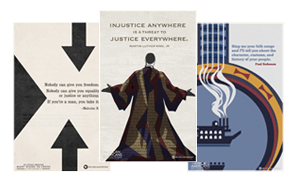African-American Histories Since the Civil Rights Movement ~ Lesson Plan
Lesson Overview
(Click here for a printer-friendly version of this lesson).
LESSON TITLE: Many Currents: African-American Histories Since the Civil Rights Movement
GRADE LEVEL: 9-12
TIME ALLOTMENT: Three 45-minute class periods
OVERVIEW
In this lesson, students learn about the diverse and divergent social and cultural paths taken by African Americans following the assassination of Dr. Martin Luther King, Jr. In the Introductory Activity, students establish to what extent their own understanding of African American history has been shaped by the classic narrative culminating in the civil rights movement. In the Learning Activities, students explore major movements and turning points in African-American history from 1968 to the present by viewing and discussing video segments from the PBS series The African Americans: Many Rivers to Cross. In the Culminating Activity, students compare and contrast the causes and effects of these different currents on the African American experience in the post-civil rights era.
SUBJECT MATTER: Social Studies, History
LEARNING OBJECTIVES
After completing this lesson, students will be able to:
- Analyze the traditional narrative of African-American history through the civil rights era
- Compare and contrast different African-American movements since the civil rights era, including the Black Panthers and the Black Power movement, Afrocentricity in culture, the rise of the black middle class, and the rise of hip hop culture in response to the War on Drugs.
- Consider the role of mass media in promoting African-American civil rights and disseminating African-American culture.
STANDARDS
From the Common Core Standards: English Language Arts, available online at http://www.corestandards.org/ELA-Literacy:
Common Core Standards, now adopted in over 40 states, are designed to help educators prepare students for success in college and careers by focusing on core knowledge and skills. The English Language Arts standards reflect the need for young people “to read, write, speak, listen, and use language effectively in a variety of content areas” including history/social studies. This curricular resource developed to accompany The African Americans: Many Rivers to Cross aligns most closely with the following Common Core Standards:
CCSS.ELA-Literacy.RH.11-12.1 Cite specific textual evidence to support analysis of primary and secondary sources, connecting insights gained from specific details to an understanding of the text as a whole.
CCSS.ELA-Literacy.RH.11-12.2 Determine the central ideas or information of a primary or secondary source; provide an accurate summary that makes clear the relationships among the key details and ideas.
CCSS.ELA-Literacy.RH.11-12.3 Evaluate various explanations for actions or events and determine which explanation best accords with textual evidence, acknowledging where the text leaves matters uncertain.
CCSS.ELA-Literacy.RH.11-12.9 Integrate information from diverse sources, both primary and secondary, into a coherent understanding of an idea or event, noting discrepancies among sources.
From the National Standards for United States History for grades 5-12, available online at http://www.nchs.ucla.edu/Standards/us-history-content-standards:
United States Era 10: Contemporary United States (1968 to the present)
Standard 1: Recent developments in foreign policy and domestic politics.
Standard 1A: The student understands domestic politics from Nixon to Carter.
Therefore, the student is able to:
- Evaluate the effectiveness of the Nixon, Ford, and Carter administrations in addressing social and environmental issues. [Assess the importance of the individual in history]
Standard 2: Economic, social, and cultural developments in contemporary United States.
Standard 2A: The student understands economic patterns since 1968.
Therefore, the student is able to:
- Explain the sluggishness in the overall rate of economic growth and the relative stagnation of wages since 1973. [Utilize quantitative data]
- Explain the increase in income disparities and evaluate its social and political consequences. [Analyze cause-and-effect relationships]
Standard 2B: The student understands the new immigration and demographic shifts.
Therefore, the student is able to:
- Explore the continuing population flow from cities to suburbs, the internal migrations from the “Rustbelt” to the “Sunbelt,” and the social and political effects of these changes. [Analyze cause-and-effect relationships]
Standard 2D: The student understands contemporary American culture.
Therefore, the student is able to:
- Analyze how social change and renewed ethnic diversity has affected artistic expression and popular culture. [Analyze cause-and-effect relationships]
- Explain the influence of media on contemporary American culture. [Explain historical continuity and change]
Standard 2E: The student understands how a democratic polity debates social issues and mediates between individual or group rights and the common good.
Therefore, the student is able to:
- Evaluate to what degree affirmative action policies have achieved their goals and assess the current debate over affirmative action. [Consider multiple perspectives]
- Evaluate the continuing grievances of racial and ethnic minorities and their recurrent reference to the nation’s charter documents. [Explain historical continuity and change]
Evaluate the continuing struggle for e pluribus unum amid debates over national vs. group identity, group rights vs. individual rights, multiculturalism, and bilingual education. [Consider multiple perspectives]
MEDIA COMPONENTS
Video
The African Americans: Many Rivers to Cross, selected segments.
Access the video segments for this lesson at the Video Segments Page.
Segment 1: “Black Power: Demanding a Brilliant Future
In the wake of Martin Luther King Jr.’s assassination, the Black Panthers advocated armed resistance and self-sufficiency for African Americans.
Segment 2: “Black is Beautiful: Afrocentricity”
Black Power helped create a new African-American cultural identity which resonated throughout American culture.
Segment 3: “The Rise of the Black Middle Class”
New political gains like affirmative action combined with changing social attitudes to nurture a growing African-American middle class, but the government continued to fear a more extreme black nationalism.
Segment 4: “The Limits of Rights: Economic Injustice”
Despite growing political power in the 1970s, African Americans continued to face daunting economic challenges made worse by the deindustrialization of their urban communities.
Segment 5: “Casualties of the War on Drugs”
President Reagan’s “War on Drugs” fell disproportionally hard on black communities as new mandatory drug sentencing laws put a generation of young African Americans behind bars.
Segment 6: “Fighting the Power: Hip Hop”
Hip Hop gave voice to a new generation of African American youth disenfranchised from the American Dream enjoyed by a select few black celebrities.
Segment 7: “Yes We Can: Obama”
Barack Obama’s election to the presidency exemplifies changing attitudes about race even as problems of institutional racism persist.
MATERIALS
For the class:
- Computer, projection screen, and speakers (for class viewing of online video segments)
For each student:
PREP FOR TEACHERS
Prior to teaching this lesson, you will need to:
- Preview all of the video segments used in the lesson. Prepare to watch them using your classroom’s Internet connection.
- Print copies of the “Many Currents: African-American Histories Since the Civil Rights Movement” Student Organizer.
Find educational resources related to this program - and access to thousands of curriculum-targeted digital resources for the classroom at PBS LearningMedia.
Visit PBS Learning Media






